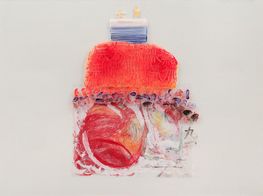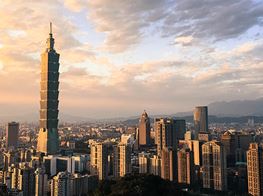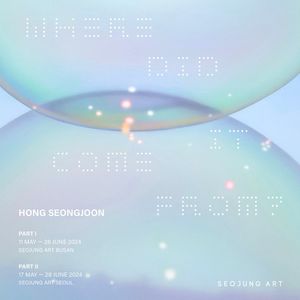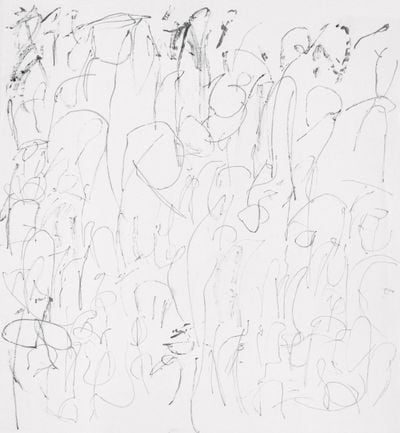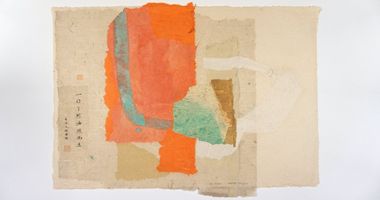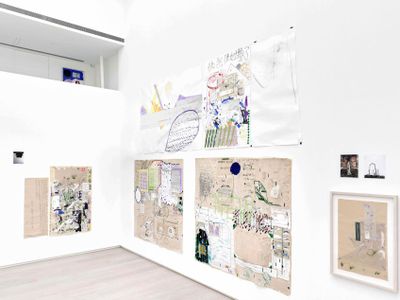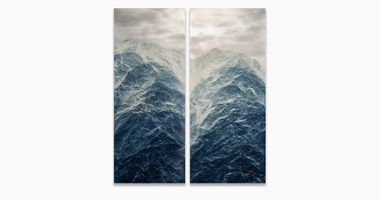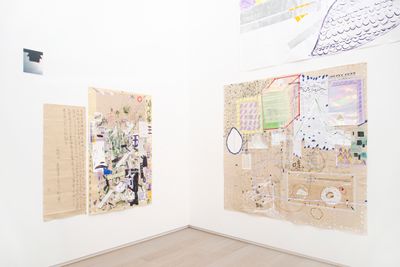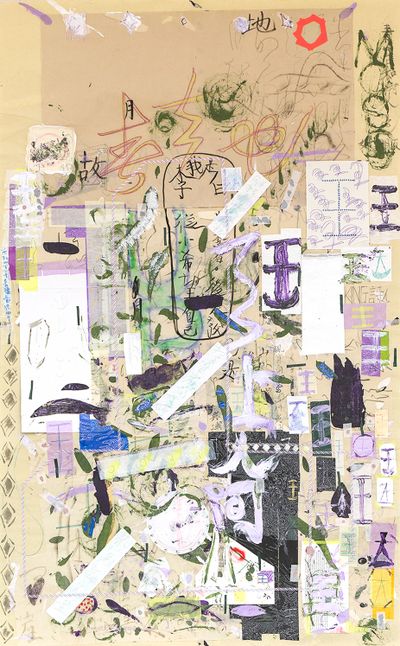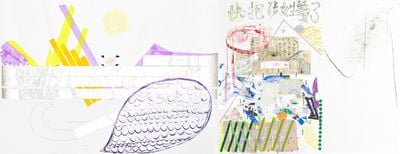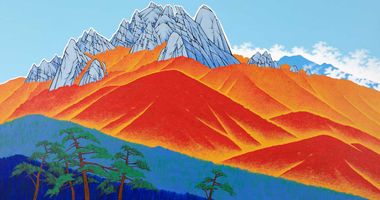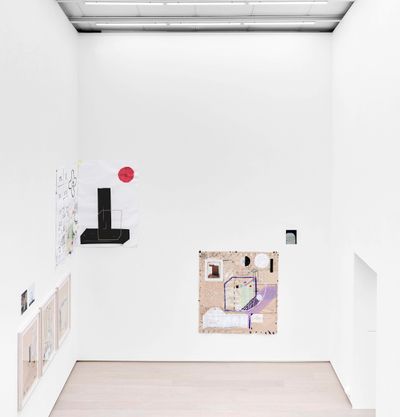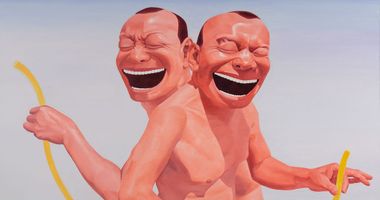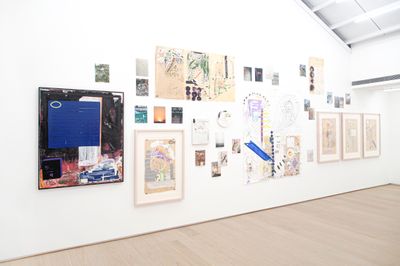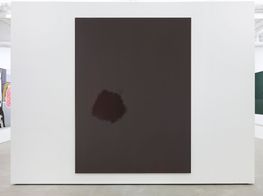Xu Jiong's Internal Landscapes
Beijing-based artist Xu Jiong's painting practice is informed by his formal training in Chinese painting and calligraphy, which the artist has evolved into experimental, expressive, and non-conformist works.
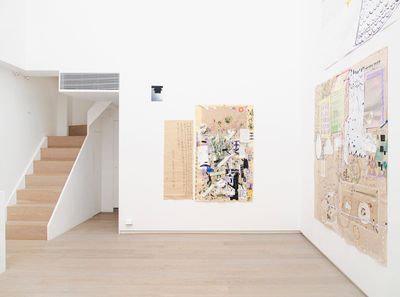
Left to right: Xu Jiong, 臨嘉慶寫東坡詩 (2022). Mixed media on paper. 125 x 50 cm; 我不是李白 I am Not LiBai (2019–2021). Mixed media on paper. 155 x 90 cm. Exhibition view: 山水 2022 SS, Each Modern, Taipei (30 August–30 September 2022). Courtesy Each Modern.
Xu's 2019 Self-portrait exhibition at Each Modern, Taipei, marked his departure from working with ink on paper alone. Non-figurative paintings composed of tower-like forms introduced experiments with acrylic paint, colourful pigments, and collage.
In these works, Xu used the formal composition of three stacked 'blocks' to deconstruct the complexities of queer identity, while engaging with text—both in the works themselves and through their titles to offer ways to decipher each painting's meaning.
This play between legibility and illegibility extends to Xu's paradoxical style, in which non-conformity is defined by an abstraction of the calligraphic line, where characters are often rendered indecipherable.
Early works like Drinking Alone (2015) feature ink scribbles on paper that potentially reference Tang poet, Li Bai, for whom wine ignited creative inspiration.
Similarly, Xu's exploration of shanshui 山水, traditional Chinese landscape painting (shan meaning mountain, shui water), detours from literal renditions of scenery to become contemporary studies of form, material, narrative, and mark-making.
This is exemplified in 山水 2022 SS, Xu's third solo exhibition at Each Modern, Taipei (30 August–30 September 2022), where an eclectic collection of 22 mixed-media paintings on different materials—paper, canvas, plywood, and even a readymade object—attests to the artist's evolving practice.
Hung as the first painting in the gallery, a 2022 work untitled in English presents a complete, fully legible calligraphic transcription of a Song dynasty poem by Su Shi, describing a peaceful and contemplative moment of solitude in the mountains.
As the only text-based, non-collaged, and ink-on-paper work in the exhibition, the piece points to Xu's classical Chinese influences, while its pairing with the painting I am Not LiBai (2019–2021) suggests an attempt to distinguish itself from those traditions.
The painting's eccentric gestures and colours reflect its declarative title, with collaged sketches in purples and yellows obscuring some of the writing in Chinese. 'Li Bai was someone whom I wished I ... then I realised...' and 'KING poet' are among the decipherable phrases, along with multiple 王 (king) characters.
Each 王 is written in varying styles like a study, an act resembling the practice of copying the writings of old masters to refine and hone one's skills before cultivating one's own.
Across the gallery's two rooms, Xu's paintings hang together in a salon style that highlights the scope of his new works. Larger paintings are showcased in the first space, making use of the gallery's vaulted ceiling.
At four metres wide, the unframed work on paper He Destroyed 10000 Artists (2021) is the biggest piece in the exhibition. Installed at the highest point above two paintings, the triptych illustrates an abstract mountainscape composed of ink, paint, coloured tape, and readymade objects that simplifies the scene into an assemblage of shapes and patterns.
Disparate elements like irregular zigzags, undulating lines, asymmetrical ovals, and geometric cut-outs overlap and co-exist with one another. They have been collaged and connected to form peaks across all three panels, alongside vibrant purple and yellow shapes occupying two-thirds of the work.
The painting's Chinese title, 快把張姓畫家賣了吧, translates to 'Let's sell (the paintings of) a Zhang-named painter'. Xu is intentionally ambiguous and likely referring to Zhang Daqian, an influential and highly prolific 20th-century Chinese ink painter renowned for his modern, impressionist approach to shanshui.
Xu has boldly written this cheeky request on the work itself, perhaps suggesting a necessary reflection on the contemporary relevance of the Chinese ink painting tradition. Other Chinese characters in the work—albeit harder to read as they are in cursive script and upside down—allude to Xu's background in calligraphy, which continues to ground his practice.
Xu's style is defined by an abstraction of the calligraphic line, where characters are often rendered indecipherable.
The salon-style hang also displays Xu's vernacular photography. Taken on his phone, the selection of eight-by-ten-inch prints of images documenting the artist's surroundings is shown alongside his paintings in the first gallery like footnotes.
Among them are snapshots of a temple roof, a construction site, a tree, and a view taken from the window of a plane—colours, shapes, and lines that find their way into the artist's formal abstractions.
In the second gallery, the installation presents more of Xu's photos on the wall, this time detailing closer observations like textures of peeling paint, grasslands, a sunset, and shadows.
More photographs are stacked on a plinth and made available to look through. They act as supporting material for two collaged series to which the accumulation of visual references is attached: 'From the Desert and the Sea' (2014–2021) and 'Meet You Again' (2015–2022).
Xu's non-conformist approach returns to a shanshui tradition that is ultimately about longing.
In both series, there are recurring motifs of the 'box', 'tower,' and 'monument'—standalone rectangular shapes that Xu employs to symbolise defining authorities like government and religion, subtly commenting on power and culture.
In From the Desert and the Sea (2021), these shapes appear with the characters 發, which has a prosperous connotation, and 匈奴, referring to the Xiongnu, also known as the Huns, a nomadic warrior population that ruled over much of Central Asia in the third-century B.C.
Taped onto the painting is a redacted page from an auction catalogue with the words 'CONTEMPORARY ART' and 'NEW YORK' rendered most visible. Juxtaposing the painting's formal abstractions, these references point to historical and cultural legacies, while perhaps critiquing the art world's commercialism.
As the larger series in the exhibition, 'From the Desert and the Sea' represents Xu's non-conformist approach by returning to a shanshui tradition that is ultimately about longing—by depicting the personal and private through an abstraction of scenery. —[O]

